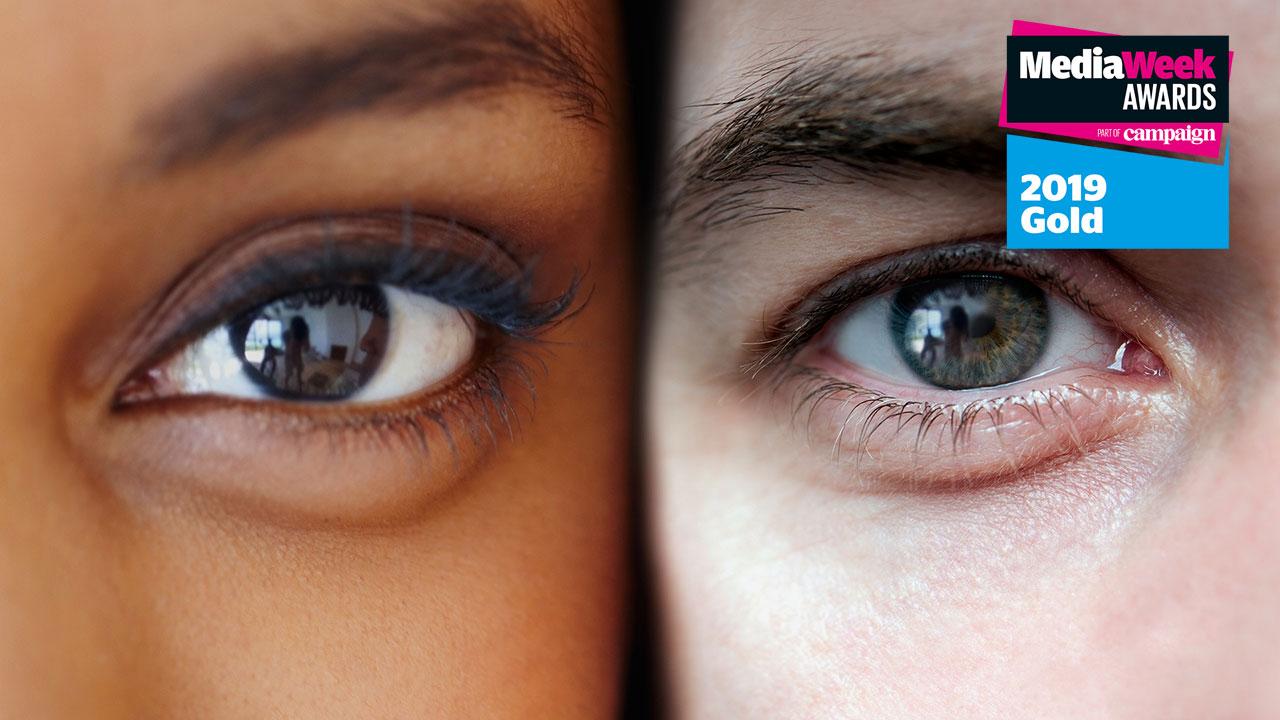In Brief
Video is firmly entrenched in our lives. Whether we’re snuggling on the sofa for an evening of telly or killing time on our mobiles before the bus arrives, the opportunities to watch have never been greater.
Back in 2013, we investigated what viewer motivations underpinned the TV we chose to watch. What drove someone to watch live TV over VOD or vice versa? What needs did these video formats satisfy? That study discovered there were six TV ‘need states’.
Since then, the video landscape has changed considerably. We wanted to revisit these need states and broaden the lens to encompass all video formats, including online.
Partnering with MTM, we detangled the role that video plays in our lives to determine how the different video formats coexist and why viewers choose to invest their time in a range of video platforms.
Key findings
- Human needs are enduring but some are more closely tied to age or life-stage than others.
- As video formats have multiplied, the range of needs fulfilled by video has expanded since we first created the need states model five years ago.
- TV satisfies the widest range of viewing needs for a greater number of people than any other video format.
- Live TV excels at delivering a shared experience and allowing us to stay in touch with the wider world.
- The desire to escape into a world of quality TV content is a major driver of viewing to both TV and subscription VOD platforms - all of which excel at fulfilling this need.
- Online video platforms (including YouTube and Facebook) serve more distinct need states that tend to be driven by function or distraction.
- The proliferation of video means that each format has been liberated to do what it does best.
The need states methodology
We recruited the research consultancy, MTM, to determine the fundamental needs that drive our video choices.
Thirty people were given camera glasses to enable them to capture their TV and video viewing in real-time. The camera glasses ensured that all viewing, regardless of location or screen, was recorded.
This resulted in over 150 days’ worth of analysable footage. By the nature of a camera glasses task, it also encompassed viewing from other household members in addition to the wearer’s own video exposure. Once the task was completed, each respondent was interviewed at length about their viewing choices and the motivations behind what they watched.
In addition, we ran an online survey of 6,000 adults to map the size of the trends we observed in the first stage of the research.
Key questions we wanted address included:
- What are the fundamental needs that drive our viewing choices and how do these needs differ for newer video platforms and forms of content? How have they evolved since our last analysis?
- What role does context have in influencing our viewing choices?
- How do viewer needs and behaviours differ across age and life-stage? What needs are most likely to endure throughout different life-stages?
Finally, we worked with a behavioural scientist to contextualise the findings within the wider framework of human behaviour.
Findings
We discovered that the role of video has diversified since we first devised the need states model back in 2013 and the different forms co-exist in our lives. There are now eight different needs that drive the majority of video consumption.
Overall, human needs stay relatively constant and the motivations for video viewing are enduring. However, the way in which we satisfy these needs with AV content has been influenced by the development – and critically the mass availability – of technology. As the video landscape has evolved, and the take-up of smart devices has risen, our appetite for AV content has increased. Video provides a means to satisfy needs that were previously fulfilled in other ways.
Critically, our research allowed us to size the need states (by time spent) across all different forms of video – including online; something that we were unable to do back in 2013.
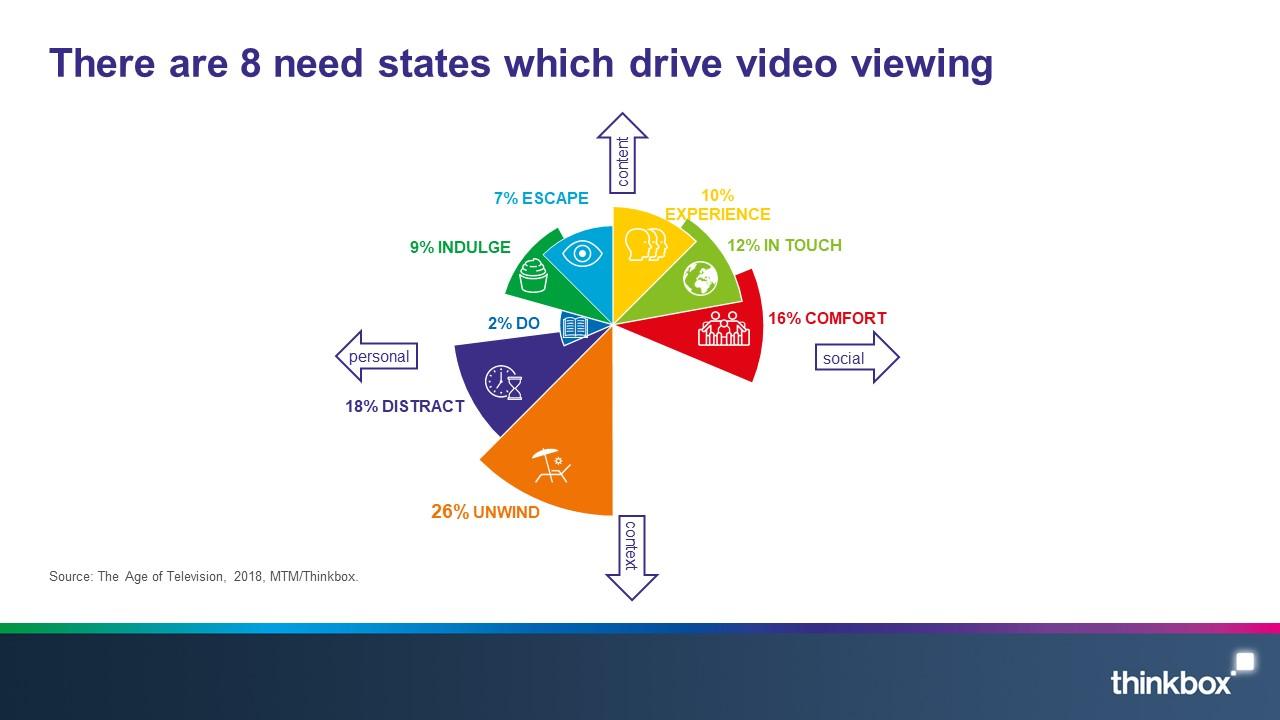
Broadcaster TV
It became apparent that TV satisfies the need states in a way that other forms of video struggle to replicate. Relaxation, entertainment and the shared experience are key.
Broadcaster TV content is the most likely to fulfil all need states bar one: ‘Do’. The motivation to unwind, to experience to escape and distract ourselves is fundamental to the reason why TV is, and will continue to be, so entrenched in our lives.
The qualitative work reaffirmed that broadcaster TV is a cherished, trusted and valued way of fulfilling a wide range of needs, but the development of newer platforms and services has been integral to future-proofing the status of broadcaster TV in the eyes of viewers.
Video on Demand
The proliferation of VOD services, which now account for 10% of the average person’s video consumption, have enhanced TV’s ability to serve different needs. This is because entire series are available on demand through both the BVOD and SVOD platforms. In fact, binge-watching has become such a commonly recognised behaviour that the term entered the Oxford English Dictionary for the first time in 2018.
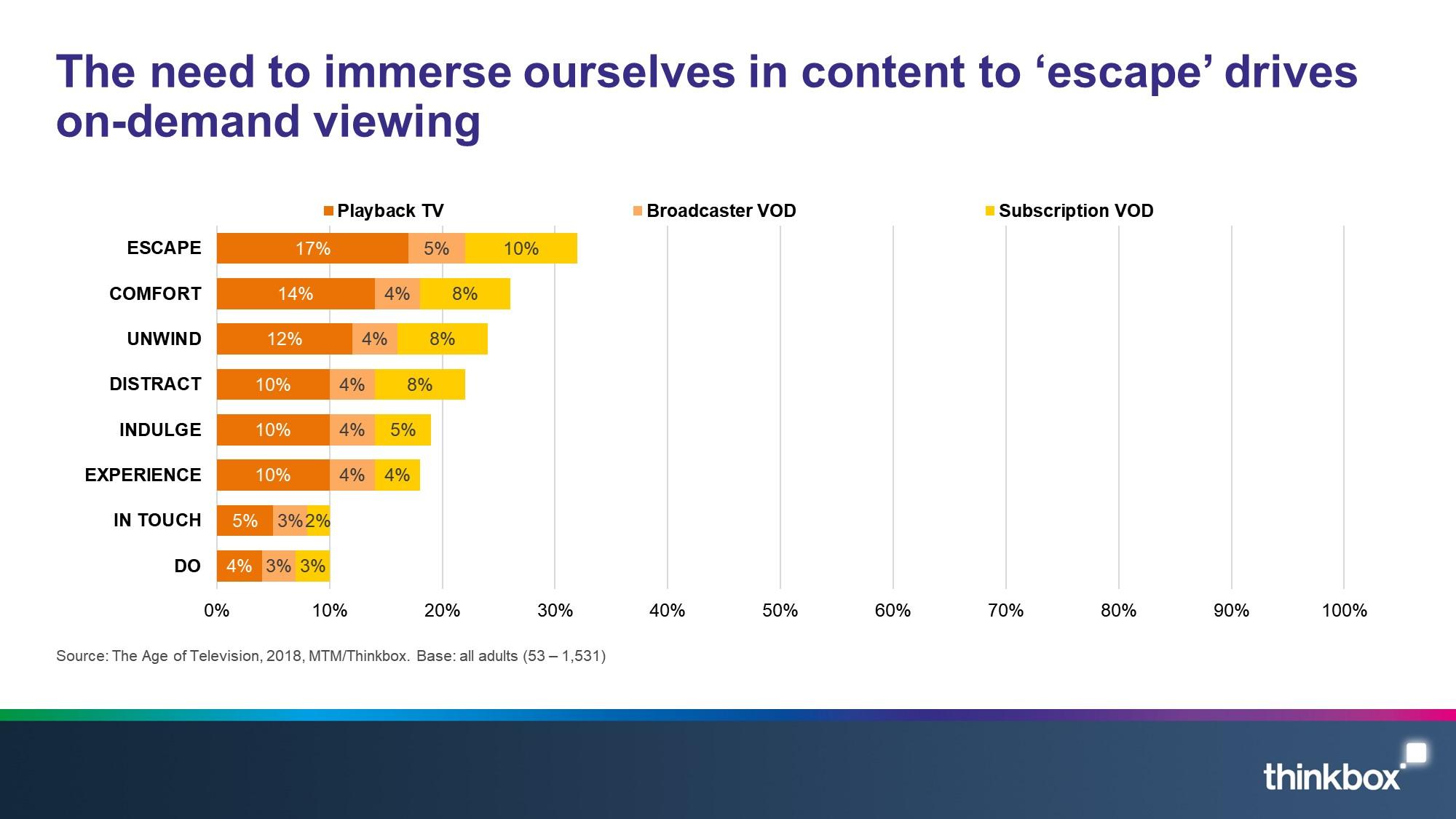
Online Video
The take-up of online video on platforms such as YouTube and Facebook has not only enabled video to better fulfil some of the need states, but it has also driven the development of new ones.
Online video accounts for 18% of all video viewing but it generally serves different functions from broadcaster TV and SVOD services. Since 2013, we’ve seen the ‘distract’ need state emerge as a key driver of online video consumption due to the prevalence of short-form content that can be watched in bite-sized chunks.
In addition, online video is three times more likely than the average video type to be the go-to destination for practical help because of the multitude of ‘how to’ guides and AV advice.
Life-stage
The impact of life-stage is generally secondary to overall human needs – most are universal but the ways we fulfil those needs differ with age. The research highlighted some key differences. For example, young people are generally more in need of distraction and less likely to stay abreast of what’s happening in the wider world through video.
The question lies in the behaviours which will endure versus those which are a product of age. Typically, young people have always had more time on their hands and a greater need for distraction, but the role of video in satisfying this need may well stay elevated later in life. The truth will come with time and further research.
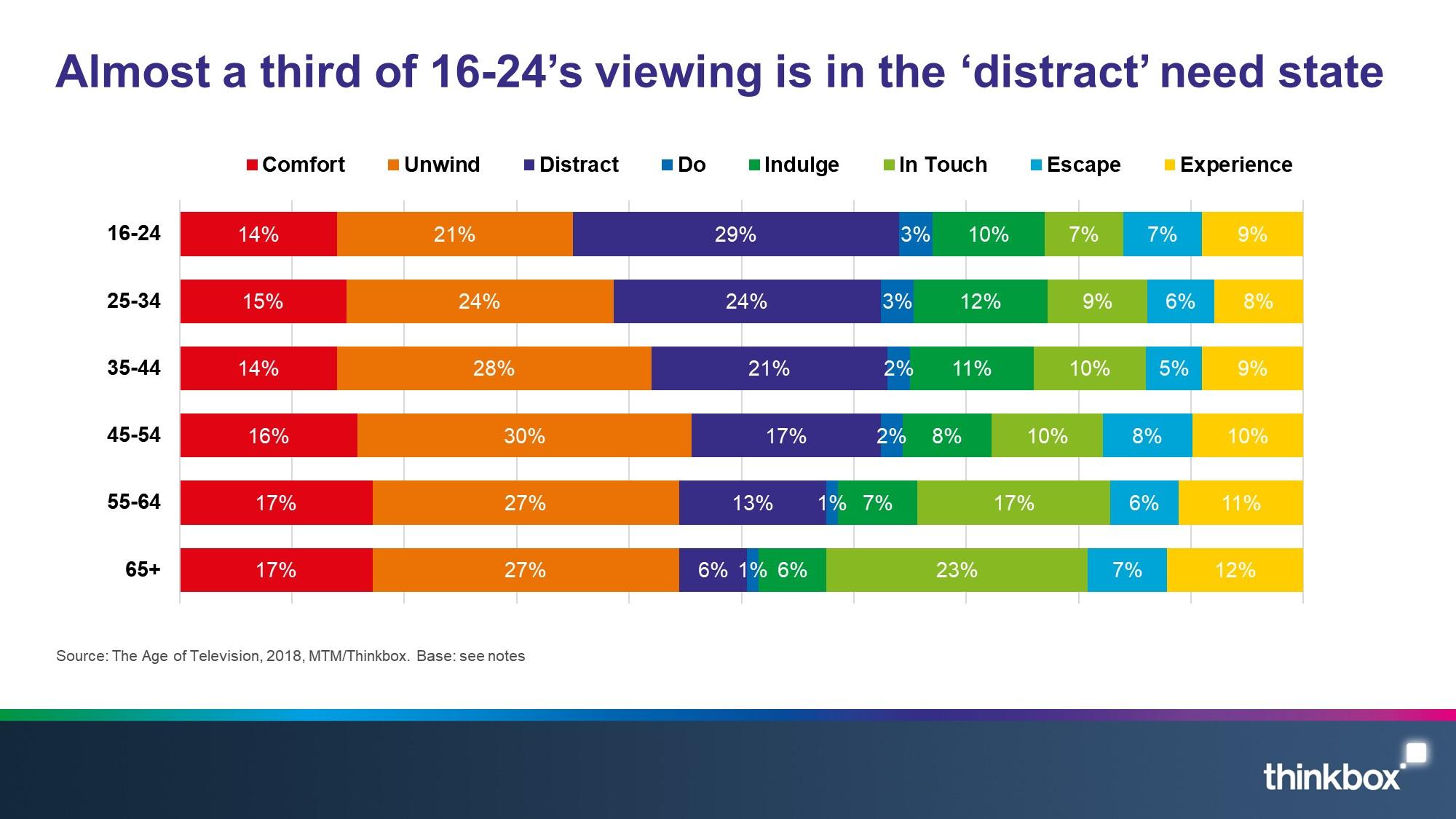
The Need States:
Unwind (26% of viewing time)
The need to relax is universal. We all need to spend time decompressing and de-stressing from the pressures of the day and video, particularly linear TV, plays a major role in allowing us to do that.
It is therefore unsurprising that this is the most enduring need state and the driver behind over a quarter of all time spent viewing video content.
From a behavioural perspective, we become increasingly fatigued as the day progresses and this impacts the way we make decisions. This is true regardless of age or life-stage. (Behavioural economists call this ‘ego depletion’). We tend to favour ‘safer’, familiar options that minimise mental exertion and maximise potential satisfaction.
This explains why many of us have similar evening routines. After we finish the activities of the day, most of us eat, wind-down and go to bed. TV is a reliable and easy source of entertainment during this period. Linear TV tends to win out over VOD in this need state, where the more deliberate act of selecting something to watch can seem like too much effort.
Key attributes:
- Linear TV is prevalent for this need state but both BVOD and SVOD are playing a role in fulfilling this need, particularly for younger audiences.
- The sofa is the go-to destination to unwinding (even for younger viewers) and we tend to unwind in the evening, after work, school or college.
- Familiarity is key. Content which lightens the mood, such as comedy, light entertainment or familiar dramas are preferred. People will happily watch programmes they have already seen when in this need state.
- For 16-34s, online video can sometimes fulfil this need via the passive serving of watching amusing videos, music videos or TV clips.
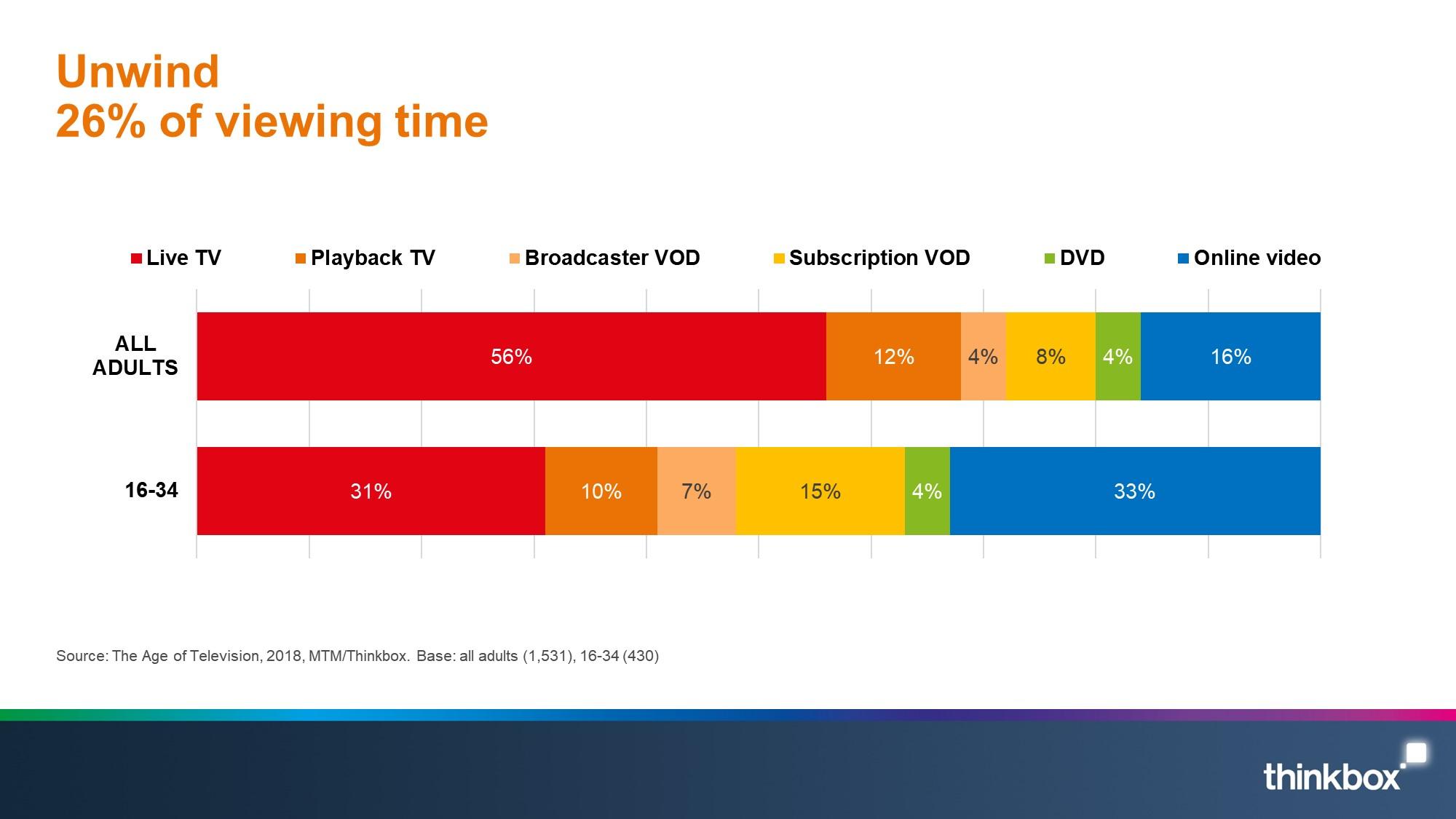
Distract (18% of viewing time)
This need state builds on our 2013 model.
With the proliferation of smartphones, distraction is now no further away than the end of our fingertips and video consumption is just one way in which we satisfy that need. The flexibility of mobile devices means that regardless of location, content can be found to punctuate the wait for the bus, the morning commute or a break at work. We can often find video to fill whatever gaps we have in our day.
This need for instant gratification is a universal trait, but for younger people – who tend to have more time to spare – it’s particularly prevalent. Video is just one way (alongside social media surfing, gaming and general browsing) to distract ourselves and generally, content that can be consumed in short, bite-sized sessions, wins out.
Key attributes:
- 29% of 16-24s video consumption is within the ‘distract’ need state whilst it only accounts for 6% of time among 65+.
- Online content is key to distraction. Short sessions (averaging 2-15 minutes) dominate and platforms are selected based on viewing context and time available.
- Short videos – generally under 5 minutes in duration – are actively selected based on the tastes and interest of the user rather than the passive serving of content. Humour, short TV, film or sports highlights, games and music dominate this need state.
- The afternoon is the most prevalent time of day for distraction, indicating that this is the time when it’s needed the most.
- Online video plays a significant role in fulfilling this need for all audiences bar the 55+, who are most likely to use the TV.
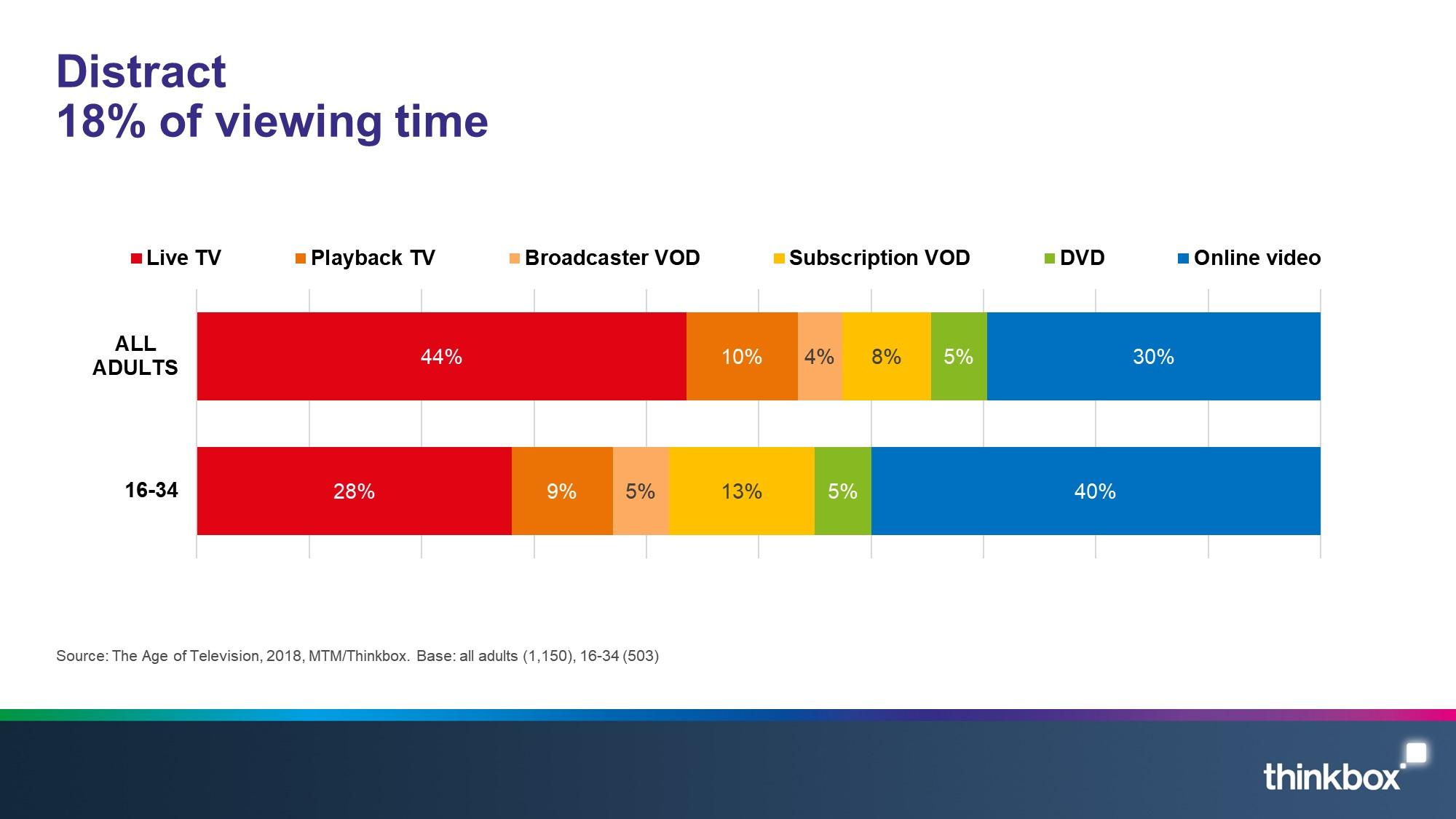
Comfort (16% of viewing time)
Humans are social creatures and we all need to spend time with those we love – particularly our partners and immediate family. This is true regardless of age or life stage and most of us recognise TV’s role in bringing households together.
TV plays an essential role in facilitating time with the people closest to us by providing a common point of focus. TV unites households in a familiar, comforting and relaxing way. The time we spend together around the TV is often planned and usually cherished. This is especially true for families with children.
Key attributes:
- Comfort accounts for 14-17% of our viewing time across all age groups.
- Comfort is a more important need amongst families, accounting for 19% of all viewing for families with children under 10 versus just 8% of viewing for 16-34s who live alone or with housemates.
- Familiar programmes and viewing routines are common within Comfort and linear TV tends to dominate.
- TV provides a way for household members to catch up with each other and spend quality time in each other’s company.
- Early evening viewing is key with viewing focused on the main TV set – most usually within the comfort of the living room.
- The choice of content is often secondary to the need to spend quality time together – compromise is common.
In Touch (12% of viewing time)
Most of us feel an innate desire to stay connected to the world around us by keeping abreast of political, social and cultural events. Developments in video mean that the ways in which we can do this are more varied than ever.
Although TV does account for the majority of ‘In Touch’ viewing, this disparity is reflected for ‘In Touch’ when it comes to age. Behaviour is relatively comparable for most of the need states, but this one sees the biggest variation of all.
For 16-34s, online video plays a more significant role, allowing them to snack on bite-sized chunks of content without the need to watch content in full. That said, this age group will happily immerse themselves in content around topics that particularly interest them, such as documentaries.
For older audiences (45+), the reliance on TV to stay in touch with the wider world is more profound.
Key attributes:
- Live TV accounts for 77% of total viewing, online video 13% and SVOD only 2% within this need state.
- Mornings features heavily for this need state, although evenings are still key. This is true for both TV and online video.
- The need to stay in touch through video is much larger amongst those aged 65 or over, accounting for 17% of all viewing time for 55-64s versus only 7% for 16-24s.
- Younger audiences tend to favour short, online video to fulfil this need, whereas older audiences prefer TV.
- Long form content plays a distinct role for 16-34s when they have a keen interest in a topic (All4, iPlayer – especially BBC3 - are key).
- For 45+, live TV, including scheduled news, and recorded or BVOD documentaries dominate.
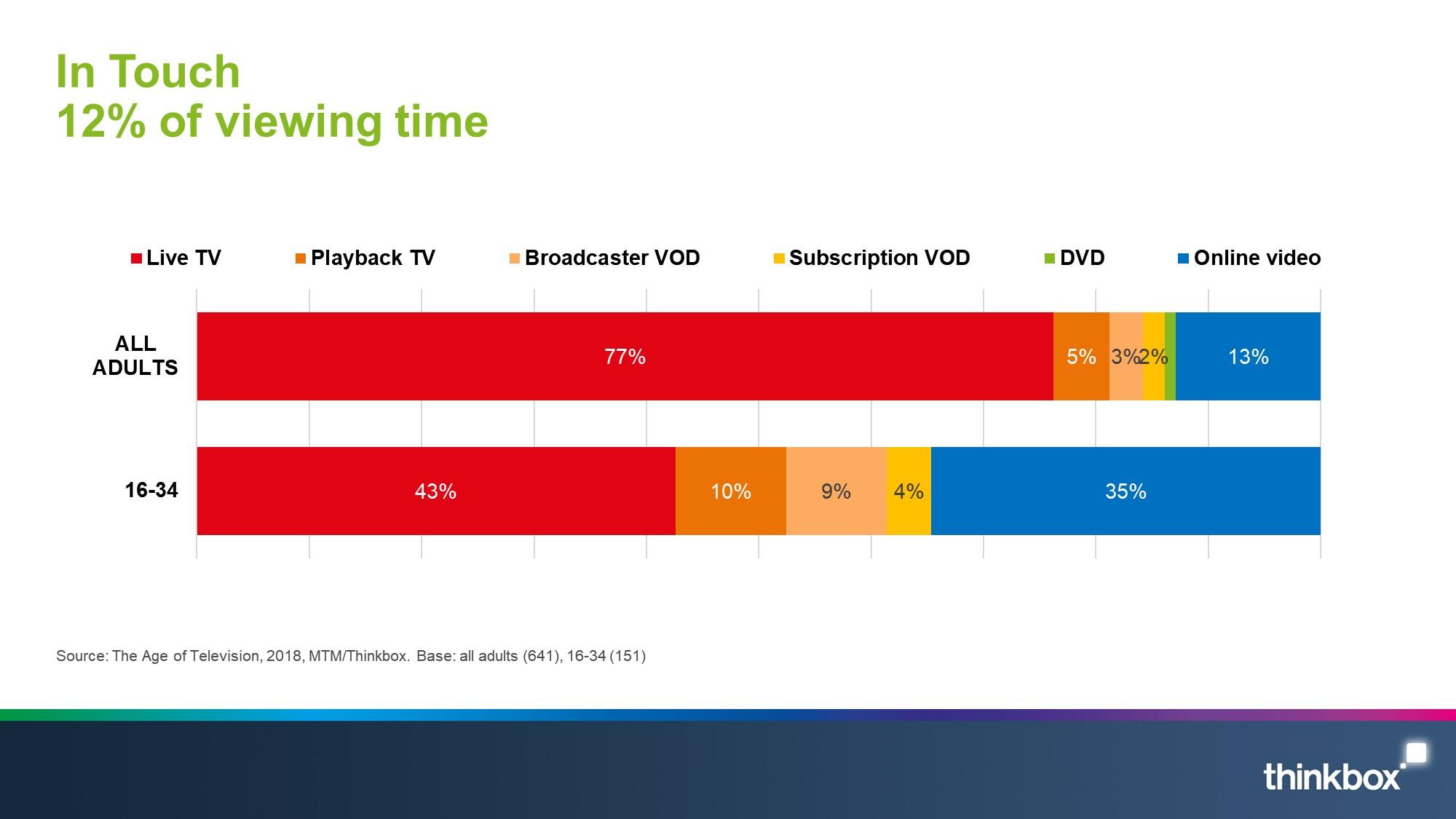
Experience (10% of viewing time)
In many ways, the video landscape has changed beyond all recognition over the last few decades but TV remains the primary means of providing a mass shared experience. We’re hard-wired to share experiences with those around us. It provides social currency and a point of connection.
The way TV satisfies the ‘Experience’ need state has been significantly enhanced over time. Online has amplified TV’s ability to provide an all-encompassing experience as conversations that would have traditionally taken place on the sofa or over the water cooler now have no boundaries. Viewers can connect with others all over the world and they can do it instantly.
This has altered the dynamic that viewers have with the video they value the most. The desire to watch in the here and now is enhanced so people can keep up with the conversation and ensure their enjoyment of their favourite programmes isn’t compromised by spoilers.
Key attributes:
- Experience accounts for 8-12% of our viewing time across all age groups.
- Live TV is an integral – and valued – way of satisfying the enduring human need to experience content at the same time as others.
- Broadcaster TV accounts for 82% of the time people spend viewing in this need state, online video 11% and SVOD just 4%.
- Online media amplify the effects of TV.
- High quality drama and entertainment shows, sporting or cultural events and big soap stories are crucial to this need state.
- The desire to watch on a big screen in the company of others is strong.
- BVOD and SVOD enable viewers to share an experience more flexibly, but the desire to watch as close to the live event as possible or watch a boxset as soon as it drops is immense. If not, the value of the overall experience diminishes.
- The viral nature of some online video also fulfils a role in this need state, particularly for younger audiences.
Indulge (9% of viewing time)
We all have our personal interests, passions and guilty pleasures and video content provides an increasingly perfect means of pursuing them.
As online video has proliferated, the ability to feed our personal interests has increased significantly and we can now fulfil this need state easily through a mix of TV and online video. This is true across all ages.
There are two sides to this need state. Firstly, the desire for ‘me time’ and to seek out personally appealing content that interests the individual rather than the household. Linear TV, BVOD and SVOD excel at this.
Secondly, the indulgence of personal and niche interests such as hobbies (e.g. gaming, make-up, photography) which would have been traditionally sated by books, websites and magazines but are now served easily by online video platforms, such as YouTube. This is particularly prevalent for the under 35s.
Online video platforms have also facilitated whole communities around niche interests that would probably never have been satisfied before, such as unboxing, spot squeezing and joint cracking.
Key attributes:
- Trusted channel brands (via linear TV, BVOD and SVOD) offer personally appealing content (such as documentaries, reality or sci-fi) that fulfil the need for ‘me-time’.
- Online video - particularly for younger viewers - allows individuals to indulge their personal interests quickly and easily.
- Online video has, in many respects, created areas of niche interest or surfaced hidden guilty pleases such as present unwrapping, ASMR and even Mukbang.
Escape (7% of viewing time)
There’s no denying that we’re in a golden age of TV. Hollywood stars regularly adorn the small screen, production budgets dwarf those of the past and top-notch producers turn stories into AV works of art.
The high quality of TV programming and the availability of content enables viewers to lose themselves in video content by escaping into different worlds or lives. It’s all about the strongest sense of personal engagement.
This need state is very much the terrain of the broadcasters and SVOD providers. For live TV, there’s the impetus to watch at the first opportunity but BVOD and SVOD services allow viewers to immerse themselves in multiple episodes of their favourite programmes if they so wish. This is particularly true of younger audiences who have a greater tendency to binge-watch TV content. This has, however, lead to some interesting new behaviour where the VOD destination is pushed to the top of the choice hierarchy until a series is finished. This means that services such as Netflix can be erratic or cyclical as they’re the top choice when viewers are immersed in a series, but quickly fall down the hierarchy as soon as that series has been watched.
Key attributes:
- Escape accounts for 5-8% of our viewing time across all age groups .
- Highly engaging content such as drama (and sometimes films and high quality documentaries) win out in this need state.
- Recency is less of an issue, it’s about deep engagement and personal appeal.
- BVOD and SVOD are significant destinations when viewers want to escape into TV content.
- BVOD has universal appeal and audiences trust services such as iPlayer and Sky boxsets to be trusted gatekeepers of quality content.
- SVOD (particularly Netflix) is a go-to destination for the under 45s, particularly those aged between 16-24.
- Platform choice tends to be driven by where the desired content is most readily and easily available (be that playback TV, BVOD or SVOD).
Do (2% of viewing time)
This need state builds on our 2013 model.
Occasionally, we all need to work out how to do something or to find an elusive fact. The need to seek out useful information quickly and easily is a fact of life for virtually everyone and the internet means the answers are available in seconds.
The availability and accessibility of online video (typically YouTube) means that online video now provides a more functional role for audiences than it has before. And whilst you can find videos on virtually any topic – from make-up tutorials to car reviews - within this need state, these videos are typically not fulfilling an entertainment role.
Unlike other forms of online video, channel subscriptions and personal recommendations are less influential here. Results are generated through searches and clicked on due to relevancy.
TV can play a role in this need state, (e.g. cooking, DIY and Open University programmes) but online video has freed up TV to focus on what it does best. Shows that would typically have a functional bias, such as The Gadget Show or Top Gear, have evolved to become more entertaining since online video became more adept at serving this need.
Key attributes:
- This need is typically fulfilled via online video sites such as YouTube.
- This has freed TV up to focus on the thing it does best – entertainment and the shared experience.
- Practical guidance and functionality is far more important in this need state than entertainment.
In summary
The proliferation of content and ease of availability across platforms means that all forms of video coexist in harmony but each has now been liberated to do what it does best.
For TV, it’s about the high quality, immersive and trusted environment that the broadcasters offer. It’s about platforms that help the viewer relax, bring households together and connect countless viewers by providing a valued shared experience. TV takes up the vast majority of our viewing time and will continue to do so for the foreseeable precisely for these reasons.
SVOD has developed to super-serve certain needs when we watch TV. It provides a valued means of binge-watching and delving into the long-tail of TV content.
YouTube fills gaps in the day with short bites of video and is a go-to destination for practical help.
In short, the current video landscape offers a multitude of opportunity for viewers to fulfil all of their viewing needs.
 Thinkbox
Thinkbox